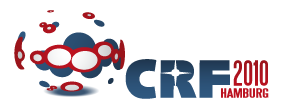Speaker
Prof.
Rychard Bouwens Bouwens
(Leiden University)
Description
The new WFC3/IR camera aboard HST enables us to survey the sky in the near-IR data 40x more efficiently than ever before -- permitting us to make enormous strides in our searches for z>=7 galaxies. Already in the first year of observations, we have deep and ultra-deep observation over 52+ arcmin**2 in legacy fields like the HUDF and GOODS. With these data, we have been able to select 80+ z~7 galaxies, 50+ z~8 galaxies, and even a promising z~10 candidate. These new selections have allowed us to quantify the evolution of the UV LF and
faint-end slope from z~10, significantly constrain the stellar populations and dust properties of z~7-10 galaxies, and construct a general picture of how galaxies build up early in the universe. In this presentation, I provide a summary of some of the early results -- giving particular emphasis to the implications for reionization and the global star formation rate density.
Author
Prof.
Rychard Bouwens Bouwens
(Leiden University)

